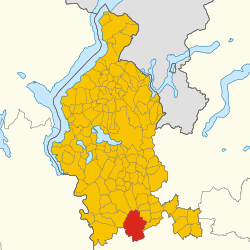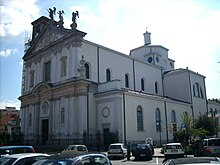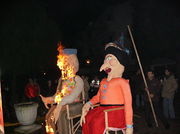Busto Arsizio
Busto Arsizio | |
|---|---|
| Comune di Busto Arsizio | |
 Shrine of Santa Maria di Piazza | |
 Busto Arsizio within the Province of Varese | |
| Country | Italy |
| Region | Lombardy |
| Province | Varese (VA) |
| Frazioni | Borsano, Sacconago |
| Government | |
| • Mayor | Gigi Farioli (LN) |
| Area | |
• Total | 30.27 km2 (11.69 sq mi) |
| Elevation | 226 m (741 ft) |
| Population (February 28, 2010)[2] | |
• Total | 81,883 |
| • Density | 2,700/km2 (7,000/sq mi) |
| Demonym | Bustocchi (for the people born in the city) Bustesi (for the people not born in the city) |
| Time zone | UTC+1 (CET) |
| • Summer (DST) | UTC+2 (CEST) |
| Postal code | 21052 |
| Dialing code | 0331 |
| Patron saint | San Giovanni Battista and San Michele Arcangelo |
| Saint day | June 24 and September 29 |
| Website | Official website |
Busto Arsizio [ˈbusto arˈsits.jo] (Lombard: Büsti Grandi) is a city and comune, in the province of Varese, in the region of Lombardy, in northern Italy, 34 kilometres (21 mi) north of Milan, but only 5 kilometres (3 mi) from the north-westernmost municipality of the city Legnano. The economy of Busto Arsizio is mainly based on industry and commerce.
History
Despite repeated claims by Lega Nord and her local allies about a Celtic heritage, recent studies seem to show that the "bustocchi"'s ancestors were Ligurians, called ‘wild’ by Pliny, ‘marauders and robbers’ by Livy and ‘unshaven and hairy’ by Pompeius Tragus. They were good at working iron and much sought after as mercenary soldiers. A very remote Ligurian influence is perceptible in the local dialect, Bustocco, slightly different from other Western Lombard varieties, according to local expert Luigi Giavini, author of a vocabulary.[3]
Traditionally these first inhabitants used to set fire to woods made of old and young oaks and black hornbeams, which at that time, covered the whole Padan Plain. This slash-and-burn practice, known as "debbio" in Italian, aimed to create fields where grapevines or cereals such as foxtail, millet and rye were grown, or just to create open spaces where stone huts with thatched roofs were built. By doing this they created a bustum (burnt, in Latin), that is a new settlement which, in order to be distinguished from the other nearby settlements, was assigned a name: arsicium (again "burnt", or better "arid") for Busto Arsizio, whose name is actually a tautology; carulfì for nearby Busto Garolfo, cava for Busto Cava, later Buscate.
The slow increase in population was helped without doubt by the Insubres, a Gaulish tribe who had arrived in successive waves by crossing the Alps about 500 years BCE. It is said that they defeated the Etruscans, who by then controlled the area, leaving some geographical names behind (Arno creek -not to be confused with Florence's river - Castronno, Caronno[disambiguation needed], Biandronno, etc.)
Busto Arsizio's site was not chosen randomly as the settlement was created on an area on the route from Milan to Lake Maggiore (called "Milan’s road", an alternative route to the existent Sempione), part of which, before the creation of the Naviglio Grande, made use of the navigational water of the Ticino river.
However, nothing is sure about Busto Arsizio's past till the 10th century, when the town's name was first discovered in documents, already with its present name: loco Busti qui dicitur Arsizio. A part of the powerful Contado of the Seprio, in 1176 its citizens are likely to have taken part (on both sides) to the famous Battle of Legnano, actually fought between Busto's frazione of Borsano and nearby Villa Cortese, when Frederick Barbarossa was defeated by the Communal militia of the Lombard League. From the 13th century the town became renowned for its production of textiles. Even its feudalization in later centuries under several lords, vassals of the masters of Milan, did not stop its slow but constant growth; nor did the plague, which hit hard in 1630, traditionally being stopped by the Virgin Mary after the bustocchi, always a pious Catholic flock, prayed for respite from the deadly epidemic.
By the half of the 19th century modern industry began to take over strongly: in a few decades Busto Arsizio became the so-called "Manchester of Italy. In 1864, while the "bustocco" Eugenio Tosi was the Archbishop of Milan, it was granted city privileges by king Victor Emmanuel II of Italy. The city kept on growing for more than a century, absorbing the nearby Comuni of Borsano and Sacconago in 1927 on a major administrative reform implemented by the Fascist regime, and was only marginally damaged even by World War II (a single Allied airdropped bomb is said to have hit the train station). This respite was given, actually, by the fact that the town hosted the important Allied liaison mission with the partisans, the Chrysler mission, led by Lt. Aldo Icardi, later famous for his involvement in the Holohan Murder Case. During the conflict Busto Arsizio was a major industrial center of war production, and the occupying Germans moved there the Italian national radio. The Italian resistance movement resorted preferably to strikes and sabotage than to overt guerrilla, since those willing to fight mostly took to the Ossola mountains, but strengthened in time, suffering grievous losses to arrests, tortures and deportation to the Nazi lager system. The names of Mauthausen-Gusen and Flossenburg concentration and extermination camps are sadly known to the bustocchi, as dozens of their fellow citizens died there. When, on 25 April 1945, the partisans took over, Busto Arsizio thus gave voice to the first free radio channel in northern Italy since the advent of Fascism.
After the war, the city turned in time increasingly on the right of the political spectrum, as its bigger industries in the Sixties and Seventies decayed, to be replaced by many familiar small enterprises and a new service-based economy. Today the town represents a major stronghold for both Forza Italia and Lega Nord right-wing political parties.
Demographics

Main sights


The most important buildings of the city are the churches. In Busto Arsizio there are several of them, built in the last millennium. Many of them are reconstructions of former churches.
Shrine of Santa Maria di Piazza
The most remarkable building of the Renaissance period, indeed the only remaining, is the shrine of Santa Maria di Piazza ("Saint Mary of the Square"), also called shrine of the Beata Vergine dell'Aiuto ("Blessed Virgin of the Help"). The building stands in the city centre. It was built between 1515 and 1522. The village of Crespi d'Adda, built up for Cristoforo Benigno Crespi, is home to a smaller version of the shrine.
Saint John the Baptist's church
The church of Saint John the Baptist, in the city center, was built between 1609 and 1635, but the bell tower is older (between 1400 and 1418). The façade, finished in 1701 by Domenico Valmagini, has many statues and decorations. In the interior are numerous of paintings by Daniele Crespi, a celebrated painter born at Busto Arsizio, such as Cristo morto con San Domenico. The square in front of this church was built over the ancient cemetery.
Saint Michael Archangel's church
The third biggest church in the city is the Church of Saint Michael Archangel (San Michele Arcangelo). Its bell tower, built in the 10th century, is the oldest building in Busto Arsizio; originally it was part of a Lombard fortification. The present church was built by the architect Francesco Maria Richini. In the church there are some relics, the most important of which is the body of San Felice Martire.
Saint Roch's church
Built up after the 1485 bubonic plague and dedicated to Saint Roch, invoked against the plague, it was rebuilt from 1706 to 1713 thanks to offerings made by the lawyer Carlo Visconti. Inside the church there are frescos by Salvatore and Francesco Maria Bianchi (1731) and Biagio Bellotti.
Museum of Textiles and Industry
The Museum of Textiles and Industry’s collections are evocative reminders of Busto’s economical history. They explain how the city developed from a small agricultural village to a thriving, industrial center of manufacturing and commerce in a few decades.
Traditional festivals

The patron saints of the city are Saint John the Baptist and Saint Michael Archangel, whose feasts are traditionally celebrated on 24 June and 29 September.
In recent times the town council has given also civic relevance to celebrations that up to now were almost completely of a religious kind. During winter it is an established tradition since time immemorial the burning of the Giöbia (alternative spelling: Giöeubia), a (usually) female puppet, symbolizing the "chasing" out of winter and its troubles, and on a more sinister note, the change from a matriarchal to a patriarchal society in ancient times. Time ago each family prepared its simple puppet to be burnt, and then its ashes were dispersed to fertilize the fields as good omen.[4] Now the celebration is more organized and publicly supported, but still heartily felt by the populace.
Music
Mina, an Italian pop star was born in Busto Arsizio. Italian violinist Uto Ughi was also born and is currently living in the city.
Sport

Busto Arsizio is the host for the Federazione Italiana Sport Croquet, the lawns being located at the "Cascina del Lupo" Sporting Centre just outside the town.
Pro Patria Calcio football club plays in Busto Arsizio (at the Carlo Speroni Stadium).
Pro Patria A.R.C. Busto Arsizio is the athletic society.
Yamamay Busto Arsizio is the main volleyball society of the city and plays in the first national division.
One of the most important athletes of Busto Arsizio is Umberto Pelizzari, born on August 28, 1965, widely considered among the best freedivers of all times. Other important athletes are the former twirling world champion Chiara Stefanazzi, the former footballers Carlo Reguzzoni, Antonio Azimonti, Aldo Marelli, Egidio Calloni and Michele Ferri.
Transport
Busto Arsizio is served by two railway stations: Busto Arsizio railway station, managed by Rete Ferroviaria Italiana, and Busto Arsizio Nord railway station, managed by Ferrovienord.
International relations
Twin towns — Sister cities
Busto Arsizio is twinned with:
 Domodossola, Italy
Domodossola, Italy Epinay-sur-Seine, France
Epinay-sur-Seine, France
References
- ^ "Superficie di Comuni Province e Regioni italiane al 9 ottobre 2011". Italian National Institute of Statistics. Retrieved 16 March 2019.
- ^ "Popolazione Residente al 1° Gennaio 2018". Italian National Institute of Statistics. Retrieved 16 March 2019.
- ^ Altro che celti, sono liguri gli avi dei bustocchiVaresenews, November 21, 2002
- ^ La Giöbia dai Liguri antichi al DuemilaVaresenews, January 25, 2007
External links
 Busto Arsizio travel guide from Wikivoyage
Busto Arsizio travel guide from Wikivoyage- Template:It icon Busto Arsizio official website

